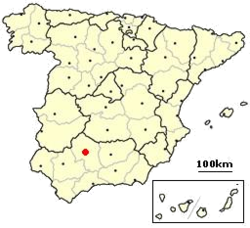Córdoba, Spain
From Wikipedia, the free encyclopedia.
- See Córdoba for other places with the same name.


Córdoba is a city in Andalucía, southern Spain, and the capital of the province of Córdoba. Located at 37.88° North, 4.77° West, on the Guadalquivir river, it was founded in ancient Roman times as Corduba by Claudius Marcellus. Its population is about 306,000 as of 2004.
Today a moderately sized modern city, the old town contains many impressive architectural reminders of when Córdoba was the thriving capital of the Caliphate of Cordoba that governed almost all of the Iberian peninsula.
Córdoba was the birthplace of three famous philosophers: the Roman stoic Seneca, the Muslim Averroes, and the Jewish Maimonides. Córdoba was also the birthplace of the Roman poet, Lucan and (more recently) of several flamenco artists including Paco Peña, Vicente Amigo, and Joaquín Cortés.
Contents |
History of Córdoba
Roman Córdoba in Hispania Baetica
In Roman times, the city had more cultural buildings than Rome. It was the capital of the province of Hispania Baetica. Remains of the Roman Temple built by Claudius Marcellus, the Roman Bridge (illustration, right) and other Roman remains can still be seen around the city.
Caliphate of Córdoba
- Main article: Caliph of Cordoba
Córdoba (Arabic قرطبه Qurṭubah) was conquered by the Moors in 711, and Moorish influence can still be felt in the city. During the time of Islamic rule, Córdoba was the largest city and embodied the most sophisticated culture and the most developed bureaucracy in Europe. When the Umayyad Caliphs were deposed in Damascus in 750, the dynasty relocated to Córdoba, ruling an emirate there until 929. When Abd-ar-rahman III submitted a rival claim to the title of Caliph, then held by the Abbasids in Baghdad, he assumed the title Caliph of Cordoba and transformed his kingdom from an emirate or sultanate into a caliphate.
Córdoba reached its peak in the 10th century, under three great rulers: the first Caliph, Abd-ar-rahman III ("al-Nasir," 912–61), his son al-Hakam II (961–76) and the dictator Al-Mansur Ibn Abi Aamir, more familiar as Almansor, "the Victorious," (981–1002). The 10th century Caliphate of Córdoba was the largest, culturally the most sophisticated polity in all Europe. Contemporary chroniclers, all of them Arabic, like the geographer Ibn Hawkal in 948, marveled, "The amount of coins in circulation! The variety of crops grown! The people!" — Córdoba may have had a quarter of a million people — "the textiles! the gardens! the mosques!" — there were more than 1,000 mosques and 600 public baths.
The German Emperor Otto I sent his emissaries to the Caliph; But in the 1020s and 1030s the whole imposing political structure collapsed, fissioning into more than a dozen successor statelets, known to historians as (the reinos de taifas) such as Seville, Badajoz, Toledo, Saragossa, Albarracín, Valencia, Almería and Granada. While they were heirs to the wealth of the Caliphate, their instability and endemic hostilities among themselves made them vulnerable to attacks from the Christian north. The history of Córdoba after the mid 11th century shrinks to the story of the city and its immediate hinterland.
The most important monument in the city is the former Mosque (the 3rd largest mosque in the world), known as the Mezquita. After the conquest, the Christians built a cathedral in the middle of this large complex, so it is two temples in one.
Another splendid monument is the city (in ruins) Medina Azahara (Arab: Madinat Al-Zahra). Other important monuments are the Alcazar, where in 1492, Christopher Columbus got permission to travel to the "Indies". The califal baths and its churchs and typical streets of the Jewish quarter Judería.
Christian Córdoba
Córdoba was recovered from the Muslims by Christian invaders of the north as part of the Reconquista in 1236, and became a center of activity against the remaining Islamic population.
Modern Córdoba
Córdoba currently has the only city government controlled by the Communist Party of Spain.
Surviving Renaissance monuments in Córdoba include the Palacio de Viana, the city's Ducal Palace.
See also
External links
- http://www.infocordoba.com An insider's guide to visiting Cordoba.
- http://www.cordoba24.info/english Attractions, hotels, restaurants, activities
- http://www.castillosnet.org/cordoba/index1.shtml




